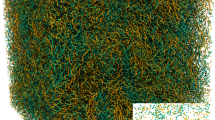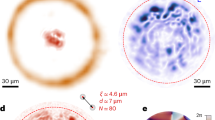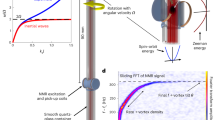Abstract
The lack of a general solution to the governing Navier–Stokes equations means that there is no fundamental theory of turbulence. In the simpler case of pure quantum turbulence, the tangle of identical singly quantized vortices in superfluids at T∼0 may provide a deeper understanding of turbulence in general. The well-known Kolmogorov theory1 predicts the energy distribution of turbulence and how it decays. In normal systems the turbulent energy is generally only a small perturbation on the total thermal energy of the supporting medium. In quantum turbulence, however, the energy is accessible. A stationary condensate is necessarily in its ground state with zero enthalpy. Thus quantum turbulence accounts for the entire free energy of the superfluid and there are no other contributions. Here, we exploit this property to make the first direct measurement of the energy released by freely decaying quantum turbulence. Our results are consistent with a Kolmogorov energy spectrum with an inferred Kolmogorov constant remarkably similar to those of classical fluids.
This is a preview of subscription content, access via your institution
Access options
Subscribe to this journal
Receive 12 print issues and online access
$259.00 per year
only $21.58 per issue
Buy this article
- Purchase on SpringerLink
- Instant access to full article PDF
Prices may be subject to local taxes which are calculated during checkout




Similar content being viewed by others
References
Kolmogorov, A. N. Dissipation of energy in the locally isotropic turbulence. Dokl. Akad. Nauk. SSSR 32, 19–21 (1941) reprinted in Proc. Roy. Soc. A 434, 15–17 (1991).
Vinen, W. F. & Niemela, J. J. Quantum turbulence. J. Low Temp. Phys. 128, 167–231 (2002).
Stalp, S. R., Skrbek, L. & Donnelly, R. J. Decay of grid turbulence in a finite channel. Phys. Rev. Lett. 82, 4831–4834 (1999).
Bradley, D. I. et al. Decay of pure quantum turbulence in superfluid 3He–B. Phys. Rev. Lett. 96, 035301 (2006).
Walmsley, P. M. et al. Dissipation of quantum turbulence in the zero temperature limit. Phys. Rev. Lett. 99, 265302 (2007).
Fisher, S. N., Guénault, A. M., Kennedy, C. J. & Pickett, G. R. Blackbody source and detector of ballistic quasiparticles in 3He B: Emission angle from a wire moving at supercritical velocity. Phys. Rev. Lett. 69, 1073–1076 (1992).
Enrico, M. P., Fisher, S. N. & Watts-Tobin, R. J. Diffuse scattering model of the thermal damping of a wire moving through superfluid 3He–B at very low temperatures. J. Low Temp. Phys. 98, 81–89 (1995).
Bäuerle, C. B., Bunkov, Y. M., Fisher, S. N. & Godfrin, H. Temperature scale and heat capacity of superfluid 3He–B in the 100 μK range. Phys. Rev. B. 57, 14381–14386 (1998).
Fisher, S. N., Guénault, A. M., Kennedy, C. J. & Pickett, G. R. Beyond the two-fluid model: Transition from linear behaviour to a velocity-independent force on a moving object in 3He. Phys. Rev. Lett. 63, 2566–2569 (1989).
Bradley, D. I. et al. Vortex generation in superfluid He-3 by a vibrating grid. J. Low Temp. Phys. 134, 381–386 (2004).
Bradley, D. I. et al. Emission of discrete vortex rings by a vibrating grid in superfluid 3He–B: A precursor to quantum turbulence. Phys. Rev. Lett. 95, 035302 (2005).
Fujiyama, S. et al. Generation, evolution, and decay of pure quantum turbulence: A full Biot–Savart simulation. Phys. Rev. B 81, 180512 (2010).
Bradley, D. I. et al. Grid turbulence in superfluid 3He–B at low temperatures. J. Low Temp. Phys. 150, 364–372 (2008).
Yeung, P. K. & and Zhou, Y. Universality of the Kolmogorov constant in numerical simulations of turbulence. Phys. Rev. E. 56, 1746–1752 (1997).
Walmsley, P. M. & Golov, A. I. Quantum and quasiclassical types of superfluid turbulence. Phys. Rev. Lett. 100, 245301 (2008).
Bradley, D. I. et al. Fluctuations and correlations of pure quantum turbulence in superfluid 3He–B. Phys. Rev. Lett. 101, 065302 (2008).
Skrbek, L., Niemela, J. J. & Donnelly, R. J. Four regimes of decaying grid turbulence in a finite channel. Phys. Rev. Lett. 85, 2973–2976 (2000).
Eltsov, V. B. et al. Quantum turbulence in a propagating superfluid vortex front. Phys. Rev. Lett. 99, 265301 (2007).
Acknowledgements
We acknowledge technical support from M. G. Ward and A. Stokes, and funding from the UK EPSRC, the FP7 European MICROKELVIN network and the Royal Society.
Author information
Authors and Affiliations
Contributions
All the authors contributed to the devising of the experiment and the analysis of the data. The experiments were carried out by D.I.B., S.N.F. and D.P. The paper was written by D.I.B., S.N.F. and G.R.P.
Corresponding author
Ethics declarations
Competing interests
The authors declare no competing financial interests.
Rights and permissions
About this article
Cite this article
Bradley, D., Fisher, S., Guénault, A. et al. Direct measurement of the energy dissipated by quantum turbulence. Nature Phys 7, 473–476 (2011). https://doi.org/10.1038/nphys1963
Received:
Accepted:
Published:
Issue date:
DOI: https://doi.org/10.1038/nphys1963
This article is cited by
-
Irreversible entropy transport enhanced by fermionic superfluidity
Nature Physics (2024)
-
Fractal dimensions in fluid dynamics and their effects on the Rayleigh problem, the Burger's Vortex and the Kelvin–Helmholtz instability
Acta Mechanica (2022)
-
Sound emission and annihilations in a programmable quantum vortex collider
Nature (2021)
-
Damping of a Micro-electromechanical Resonator in the Presence of Quantum Turbulence Generated by a Quartz Tuning Fork
Journal of Low Temperature Physics (2020)
-
Knot spectrum of turbulence
Scientific Reports (2019)



